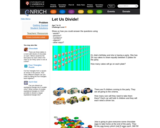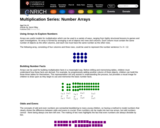
This three-act math task utilizes videos and questioning to help students explore multiplication and division beyond 1000.
- Subject:
- Mathematics
- Material Type:
- Activity/Lab
- Provider:
- GFletchy
- Author:
- Graham Fletcher
- Date Added:
- 10/25/2022

This three-act math task utilizes videos and questioning to help students explore multiplication and division beyond 1000.

In this problem students practice addition and subtraction (and possibly multiplication) while developing systematic work strategies. Given two types of ladybirds, each with either 4 or 7 spots, learners explore ways of combining them to achieve different total numbers of spots. The Teachers' Notes page offers rationale, suggestions for implementation, discussion questions, ideas for extension and support, and links to related games.

This collection of division word problems prompts learners to use a variety of methods of division. Allowing learners to choose their own method to solve the word problems enables them to see the strengths and weaknesses of various methods and to see why certain methods might be better for specific problems. Included with these problems is the solution, teacher resource page, tips on getting started, and a printable student page.

This problem requires children to make sense of information and to work in a systematic way. The interactive is a machine with four colored lights, each corresponding to a rule regarding number properties. Students are to discover numbers that will satisfy all four rules and switch on all the lights. The Teachers' Notes page offers rationale, suggestions for implementation, discussion questions, ideas for extension and support.

This activity gives students a chance to make estimates and comparisons of the measures of length (height) and capacity. It presents an image of a tiny elf next to a normal size mug. Students are asked to estimate the Little Man's height and compare it with that of other objects. Next, they are asked to estimate the height and volume of the Little Man's mug. The Teachers' Notes page includes suggestions for implementation, discussion questions, and ideas for extension and support.

This problem allows students to explore introductory multiplication and division concepts in the context of sharing cookies ("biscuits" in the UK). Cookies are displayed in two different arrays, and students are challenged to divide them equally among two, three, five, and six people and to deal with remainders. The Teachers' Notes page offers rationale, suggestions for implementation, discussion questions, ideas for extension and support, and a printable sheet (pdf).

In this problem students apply different strategies to solve a problem involving multiples and remainders. The problem provides clues about dividing a specific number of lollipops equally and asks solvers to determine possible totals. The problem presents three partial approaches and asks solvers to complete them. This resource includes hints for getting started, previously submitted solutions, and a teacher page with implementation suggestions, discussion questions, and differentiation strategies.

This problem uses the context of a growing plant in which to practice doubling and also to develop representation and recording strategies. The Teachers' Notes page offers suggestions for implementation and discussion as well as ideas for extension and support.

This problem uses linking cubes as a concrete context for exploring simple multiplication and division, doubling, halves and quarters. The problem displays a rod of 4 cubes and asks students how many cubes are necessary to make rods related to it in a variety of ways. It can be used to introduce key concepts and vocabulary. The Teachers' Notes page offers suggestions for implementation, discussion questions, and ideas for extension and support.

The purpose of the task is for students to solve a multi-step multiplication problem in a context that involves area. In addition, the numbers were chosen to determine if students have a common misconception related to multiplication.

Learn how to do multiplication in Excel.

This activity is a good way of introducing the value of algebraic notation and translating verbal expressions to algebraic expressions. Students are asked "to think of a number," then to do seven consecutive computational steps beginning with their number and to figure out why 2 is always the final result. The teacher's notes, hints, and solution are provided.

This problem reinforces a learner's understanding of factors and multiples. Students are presented with the hundred grid or parts of the grid where specific numbers have been shaded and must find out which factors have been chosen in order to produce the shading. A link to a spreadsheet which shades the squares according to the chosen factors, can be used by students to check their hypotheses. The Teachers' Notes page offers rationale, suggestions for implementation, discussion questions, and ideas for extension and support.

The focus of the Multiplication - Distributive Property intervention is using the distributive property when multiplying by 6, 7, and 8. It involves making arrays with counters and then breaking them apart to make facts that are known by heart which can be added together to solve the multiplication problem.

In this math skill-based practice activity, students strengthen their understanding of associative, commutative, and distributive properties. They complete a vocabulary challenge with definitions.

This one-page article describes and illustrates how arrays can be used to represent many number concepts, including building multiplication facts, commutativity, parity (odd/even), and exploring factors, prime numbers, and square numbers.

This interactive Flash version of the familiar Concentration game ("pelmanism" in the UK) helps a single user practice multiplication facts while developing memory and concentration skills. The player can choose an array of 16, 20, or 24 cards, which appear face down. The goal is to flip two cards at a time to match all the pairs of factors with their products as efficiently as possible. A scoring feature discourages random guessing. Users can choose to work with factors in three ranges: 2x-10x, 2x-21x, or 11x-21x. Printable versions of the game cards are available to download.

This lesson is an introducation lesson to multplying and dividing within 100 using the different strategies such as equal groups, arrays, and measurement quantities. *Image from Lesson Plan

This three-act math task utilizes videos and questioning to help students explore multiplying and dividing fractions.

This problem provides an opportunity for children to explore and visualize number patterns and sequences and to reinforce key number concepts and vocabulary such as odd and even, factors and multiples. Students cut consecutive number tracks into equal length pieces in several ways and investigate the patterns that emerge among the sums of the tracks. The Teachers' Notes page explains number tracks and offers suggestions for implementation, discussion questions, a printable sheet of number tracks (pdf), and ideas for extension and support.